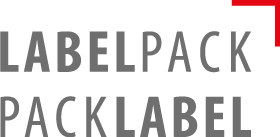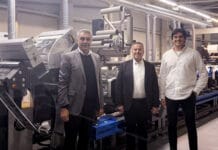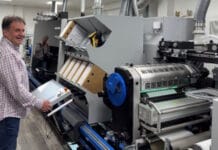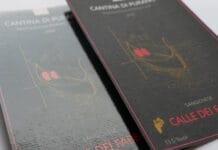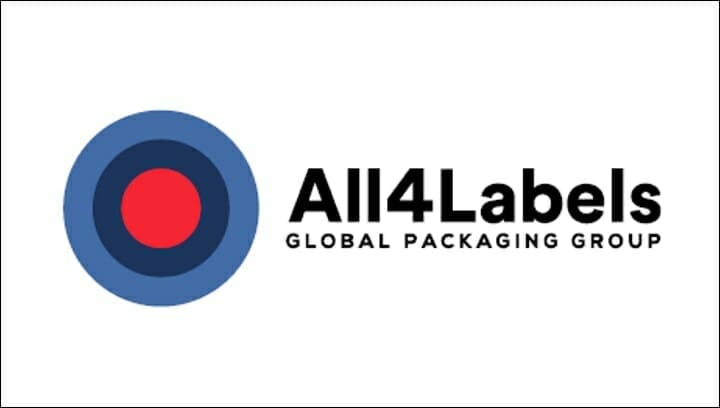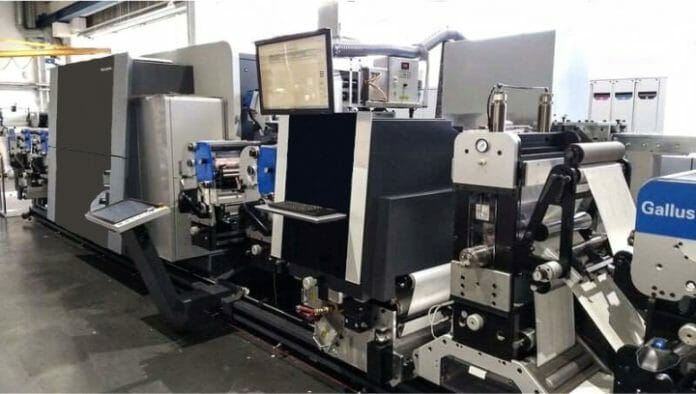
Dieter Finna (Click here for a German version)
Philip Morris International (PMI) is continuously working to integrate digital folding carton printing into their production environment.
The transformation of folding carton printing is currently taking place at PMI’s Development Center in Switzerland. What is so special about it? To start with, an international brand owner deciding itself to push the boundaries of digital printing. How? By equipping a digital label printing machine for printing folding carton. The company invested in a Gallus Labelfire, which is being developed into an end-to-end digital printing solution (click here).
PMI’s move is radical and so is the reason they’re doing it. The change in product portfolio now including smoke-free products requires a drastically reduced time-to-market, which was not possible by simply optimizing the supply chain in conventional printing. Digital printing came into play offering that required flexibility and speed, but it did not cover all the requirements in terms of cost and capabilities. PMI saw the benefits of digital printing at a very early stage and decided not to wait until a finished solution became available on the market, but to actively work on further developing the digital solution itself. A hybrid digital printing machine was installed in the Development Center in Neuchâtel/CH.
Decision for a Gallus Labelfire 340
As the name Labelfire suggests, the type of machine is a model that is conceptually designed for label printing. The reason behind the choice lies in the modularity of the machine, says PMI. As a hybrid machine, Gallus Labelfire combines the analogue printing and embellishing processes still required today with the versatility of digital printing. According to Gallus, this machine configuration is the longest version of a Labelfire built so far.
Gallus had to make some adjustments in order to equip the label printing machine with a working width of 340 mm for printing on board to cover a wide range of board types up to more than 300 g/m2. This business requirement led to considerable technical challenges to adapt the machine, i.e. web tension / machine re-enforcement, but with close collaboration between Gallus and PMI, they were overcome successfully.
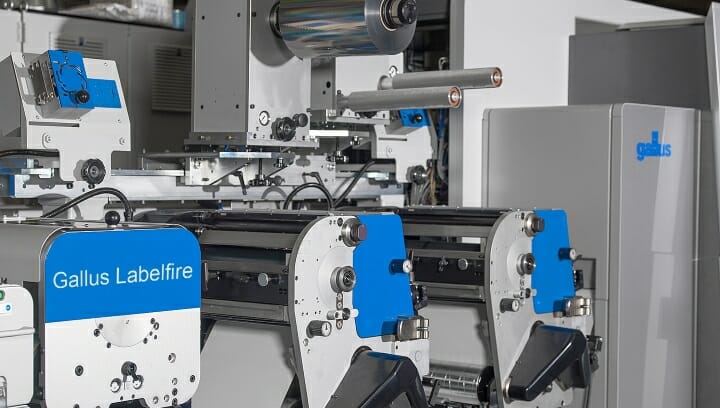
Machine layout
The machine is equipped with two flexographic printing units in front of the digital printing unit. The flexo units are used to achieve metallic effects on cold foil. Likewise, White can be applied at this point to partially cover metallic foil or specially laminated substrate types. Next is a digital printing unit equipped with eight UV colours, covering CMYK, extended gamut printing plus digital White. Fujifilm Dimatix Samba printheads are used to enable a print speed of 50 m/Min. at a physical resolution of 1200 x 1200 dpi.
The digital printing unit is followed by two flexo units with which matt varnish or gloss varnish can be applied. At the end of the line, each pack is partially coated in flexographic printing to protect the surface of the blanks and adjust for the coefficient of friction for high packaging speeds. However, due to specific design needs, PMI has included additional flexo units which were installed downstream.
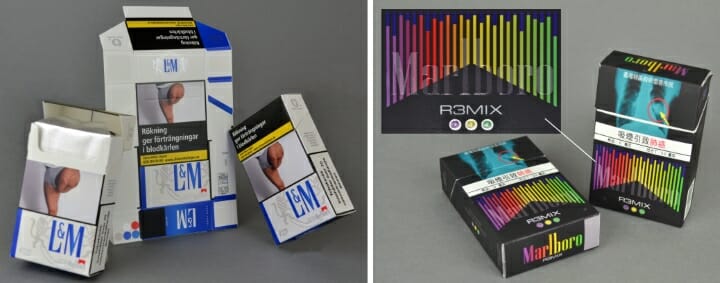
Right: Print with extended color gamut including White. The matt effect in Black is achieved by applying a UV soft touch lacquer. In contrast, the glossy soft touch lacquer emphasizes the colored elements, visible in the Marlboro lettering. Clearly visible are the reflections of the embossing edge below the letters »rlbo« in the enlarged picture. (Source: pack.consult)
All digital?
For PMI, a clearly defined goal is to digitize all printing and converting steps in the future. As early as December 2018, an offline laser die-cutter for cutting and creasing was installed to further explore digital converting possibilities.
In addition, following PMI’s digital concept to extend the digital embellishment applications, a new digital embellishment unit will be integrated into the machine platform, which incorporates the implementation of Schmid-Rhyner’s patented digital varnishing technology (diVar) into the digital embellishment unit (DEU), which was jointly developed by Steinemann and Gallus. The digital embellishment unit has been dimensioned so compactly that all units fit inline into the narrow-web machine, including curing, ozone extraction and cooling.
»A digital solution for PMI will only lead the way when the digital end-to-end production can be put into practice.«
The entire embellishment spectrum becomes possible
The uniqueness of the digital embellishment system is that it will enable digital varnishing, covering spot or continuous gloss and other effects. For this purpose, Schmid-Rhyner developed a UV-curable inkjet varnish which can be applied at a printing speed of 50 m/Min. up to a quantity of 25 g/m2, which corresponds to an application thickness of 25 μm. Reducing the print speed to 25 m/Min. could even increase the amount to 50 g/m2.
Practical examples
Designs of more than 200 SKUs have already been printed on the digital printing line. These are mainly smaller print runs and requirements for various markets. A small selection of the printed packaging shows the images that were previously produced without the embellishment unit on the »Boardfire«.
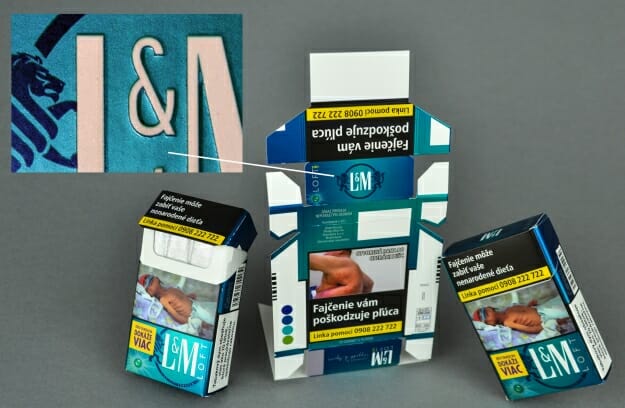
In general, PMI uses stochastic screens, resulting in the finest vignettes to zero. The brand colours such as Marlboro Red or L&M Blue are made of screened separations of process colours. To apply metallic effects, the cold foil is overprinted. In this way, metallic effects can be generated in a variety of shades, which appear different from every viewing angle. Matt gloss effects are also used, which effectively support the design of the packaging. All printing examples are in a final processing step offline creased and die-cut.
Proximity to production
Philip Morris has established a true commercial packaging production at the Development Center in Neuchâtel, where small to medium-sized print runs can be industrially produced. With a continuous development to strive for a digital end-to-end solution, PMI is at the forefront to explore and lead new technology opportunities. To further validate and test the technology under real commercial conditions, PMI has invested in additional equipment to be installed in one of their production sites in 2019. As Tony Snyder mentioned at the digital print for packaging conference in Berlin, this could ultimately lead to a digital printing line being available in every production site in the future.
Philip Morris International
In 1847, Mr. Philip Morris opened a shop on London’s Bond Street. Today, Philip Morris is a leading international tobacco company with a diverse workforce of around 81,000 people. In 1924 Marlboro, which has become the company’s most famous brand, was introduced. In the 1950s, an internal operating division was launched to manufacture and market products around the world. The PMI operations center was transferred from Rye Brooks, NY (USA) to Lausanne, Switzerland in 2001 and in 2009 PMI unveiled its new research- and development facility in Neuchâtel (Switzerland) bringing together over 400 scientists, specialists, and staff in a new world-class facility dedicated to development of reduced–risk products. The company made a far-reaching decision, to build the future on smoke-free products and to replace cigarettes as soon as possible.
